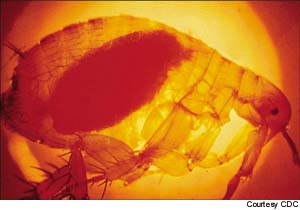PLAGUE TRANSMISSION
The way in which plague spreads is one of the most interesting features of the disease. It is not primarily a disease of man at all, but of rodents. In Europe the rodent affected was the black rat, Rattus rattus. This is essentially a climbing animal, which lives in walls and roofs, always in close contact with man. The Plague bacillus is carried from rat to rat by the bite of the rat flea.
Like most fleas, Xenopsylla cheopsis, the rat flea, prefers to feed on a single species of animal, and will only bite humans when an outbreak of rat Plague has left insufficient rats to feed on. This means that human epidemics always follow rat epidemics. Interestingly there are no European records of an increased number of dead rats before the humans fell sick before or during the Black Death.
The mouth-parts of the rat flea are a very efficient means of transmitting the Plague, and function rather like a combined syringe, needle and blood- culture bottle. When an infected rat is bitten, a bloody suspension of living Plague bacilli goes into the flea's stomach, where they multiply and block the gut. The flea becomes hungry, but cannot feed until this blockage is broken. It is then termed a blocked flea.
When the flea bites the next victim, the flea injects its previous meal, now a mass of living Plague bacilli.
In a few days the lymph nodes near the bitten area form buboes, and a new case of Plague appears.
The particular fear of Plague above all other diseases was the mysterious way it was passed on: there was something inexplicable and almost supernatural about a disease which could not be contained by normal quarantine measures. Only at the end of the last century, with the discovery of the organism and its mode of passage, was the mystery fully solved.
